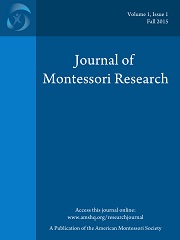Montessori and Non-Montessori Early Childhood Teachers’ Attitudes Towards Inclusion and Access
DOI :
https://doi.org/10.17161/jomr.v1i1.4944Mots-clés :
inclusion, attitudes, Montessori, early childhood, teachers, accessRésumé
Montessori and non-Montessori general education early childhood teachers were surveyed about their attitudes towards including children with disabilities and providing access in their classrooms. Both groups reported similar and positive supports for inclusion within their schools. Montessori teachers reported having less knowledge about inclusion and less special education professional development than their non-Montessori counterparts. Implications for professional development and teacher preparation are described.
Références
American Montessori Society (AMS). (2014). AMS teacher education programs. Retrieved
from http://www.amshq.org/Teacher%20Resources/AMS%20Teacher%20Education%20Programs.aspx
American Montessori Society (AMS). (2014). Introduction to Montessori. Retrieved from
http://www.amshq.org/Montessori%20Education/Introduction%20to%20Montessori/Montessori%20Schools.aspx
Burke, K., & Sutherland, C. (2004). Attitudes toward inclusion: Knowledge vs. experience.
Education, 125(2), 163-172.
Buysse, V., Skinner, D., & Grant, S. (2001). Toward a definition of quality inclusion:
Perspectives of parents and practitioners. Journal of Early Intervention, 24(2), 146-161.
Cossentino, J. (2010). Following all the children: Early intervention and Montessori. Montessori
Life, 1(8), 1-8.
DEC / NAEYC. (2009). Early childhood inclusion: A joint position statement of the Division for
Early Childhood (DEC) and the National Association for the Education of Young Children (NAEYC). Chapel Hill, NC: The University of North Carolina, FPG Child Development Institute.
Epstein, A. (1997). How teachers accommodate for young children with special needs.
Montessori Life, 9(3), 32-34.
Epstein, A. (1998). "The behavior part is the hardest": Montessori teachers and young children
with challenging behaviors. Montessori Life, 10(4), 24-25.
Epstein, A. M. (1996; 1996). Teacher accommodation for individual differences in integrated
Montessori early childhood classrooms. (University of Maryland College Park, University of Maryland College Park). ProQuest Dissertations and Theses,
Hurley, J. J., & Horn, E. M. (2010). Family and professional priorities for inclusive early
childhood settings. Journal of Early Intervention, 32, 335-350.
Individuals with Disabilities Education Improvement Act of 2004, PL 108-446, 20 U.S.C. §§
et seq. (2004).
Kahn, B. (2009). 2009 NAMTA baseline special education survey. The North American
Montessori Teachers' Association Journal, 34(2), 181-196.
Kirk, S., Gallagher, J., J., Coleman, M. R., & Anastasiow, N. J. (2011). Educating exceptional
children (13th ed.). Belmont, CA: Wadsworth Publishing.
Knoche, L., Peterson, C. A., Edwards, C. P., & Jeon, H. (2006). Child care for children with and
without disabilities: The provider, observer, and parent perspectives. Early Childhood
Research Quarterly, 21(1), 93-109.
Lillard, A., & Else-Quest, N. (2006). The early years: Evaluating Montessori education. Science,
(5795), 1893-1894.
McKenzie, G. K. &. Zascavage, V. (2012). Montessori instruction: A model for inclusion in
early childhood classrooms and beyond. Montessori Life, 24(1), 20-25.
Miller, L. B., Dyer, J. L., Stevenson, H., & White, S. H. (1975). Four preschool programs: Their
dimensions and effects. Monographs of the Society for Research in Child Development,
, 1-170.
National Association for the Education of Young Children (NAEYC). (2012). Guidance on
NAEYC accreditation criteria: All criteria document. Retrieved from
http://www.naeyc.org/files/academy/file/AllCriteriaDocument.pdf
National Professional Development Center on Inclusion. (2011). Research synthesis points on
practices that support inclusion. Chapel Hill, NC: The University of North Carolina, FPG Child Development Institute.
Odom, S. L., Buysse, V., & Soukakou, E. (2011). Inclusion for young children with disabilities:
A quarter century of research perspectives. Journal of Early Intervention, 33(4), 344-356.
Pickering, J. S. (1992). Successful applications of Montessori methods with children at risk for
learning disabilities. Annals of Dyslexia, 42(1), 90-101.
Pickering, J. S. (2008). Montessorians helping children who learn differently. The North
American Montessori Teachers' Association Journal, 33(2), 77-99.
Sandall, S. R., Hemmeter, M. L., Smith, B. J., & McLean, M. E. (2005). DEC recommended
practices: A comprehensive guide for practical applications in early intervention/ early childhood special education. Missoula, MT: Division for Early Childhood.
Sandall, S. R., & Schwartz, I. S. (2008). Building blocks for teaching preschoolers with special
needs (2nd ed.). Baltimore, MD: Paul H Brookes Pub Co.
Schwartz, I. S., Sandall, S. R., Odom, S. L., Horn, E., & Beckman, P., J. (2002). "I know it when
I see it": In search of a common definition of inclusion. In S. Odom (Ed.), Widening the
circle: Including children with disabilities in preschool programs (pp. 10-24). New York, NY: Teachers College Press.
Triandis, H. C. (1971). Attitude and attitude change. New York, NY: John Wiley & Sons Inc.
U.S. Department of Education, Office of Special Education and Rehabilitative Services, Office
of Special Education Programs. (2009). 28th annual report to congress on the implementation of the Individuals with Disabilities Education Act, 2006 vol. 1. ( No. Contract No. ED01CO0082/0008). Washington, D.C.: U.S. Department of Education.
Wolfe, J. (2002). Learning from the past: Historical voices in early childhood education (2nd
ed., pp. 225-248). Mayerthorpe, Alberta, Canada: Piney Branch Press.


